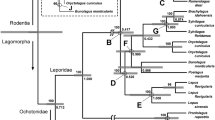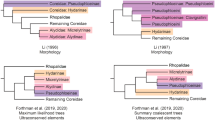Abstract
Results of the use of the fingerprinting method related to short interspersed elements (SINEs), inter-SINE–PCR, in the study of phylogenetic and taxonomic relationship in mammals from orders Chiroptera (family Vespertilionidae) and Lipotyphla (family Erinaceidae) are reported. The inter-SINE–PCR method is based on the amplification of fragments situated between copies of SINEs, which are short retroposons spaced 100 to 1000 bp apart. Specifically selected primers were used, which are complementary to consensus sequences of two short retroposons: the mammalian interspersed repeat (MIR), which is typical of all mammals and some other vertebrates, was used in the cases of bats and Erinaceidae, and the ERI-1 element recently isolated from the genome of the Daurian hedgehog was used in the case of Erinaceidae. The results support the current view on phylogenetic relationship between hedgehogs belonging to genera Erinaceus, Hemiechinus, and Paraechinus (but not the genus Atelerix). In bats, the phylogenetic reconstruction revealed a statistically valid topology only at lower taxonomic levels, whereas the topology for the genus and supragenus ranks was unresolved and fan-shaped. The benefits and limitations of the inter-SINE–PCR method are discussed.
Similar content being viewed by others
REFERENCES
Williams, G.K., Kubelik, A.R., Livak, J., et al., DNA Polymorphisms Amplified by Arbitrary Primers Are Useful as Genetic Markers, Nucleic Acids Res., 1990, vol. 18, no. 22, pp. 6531-6535.
Zietkiewicz, E., Rafalski, A., and Labuda, D., Genome Fingerprinting by Simple Sequence Report (SSR)-Anchored Polymerase Chain Reaction Amplification, Genomics, 1994, vol. 20, pp. 176-183.
Vos, P., Hogers, R., Bleeker, M., et al., AFLP: A New Technique for DNA Fingerprinting, Nucleic Acids Res., 1995, vol. 23, no. 21, pp.4407-4414.
Kramerov, D.A., Kraev, A.S., Ryskov, A.P., and Skryabin, K.G., The Primary Structure of the Mouse Highly Repetitive Sequence Homologous to Double-Stranded Pre-mRNA Regions, Dokl. Akad. Nauk SSSR, 1980, vol. 252, pp. 241-244.
Singer, M.F., SINEs and LINEs: Highly Repeated Short and Long Interspersed Sequences in Mammalian Genomes, Cell (Cambridge, Mass.), 1982, vol. 28, pp.433-434.
Okada, N., SINEs, Curr. Opin. Genet. Dev., 1990, vol. 1, pp. 498-504.
Serdobova, I.M. and Kramerov, D.A., Short Retroposons of the B2 Superfamily: Evolution and Application for the Study of Rodent Phylogeny, J. Mol. Evol., 1998, vol. 46, pp. 202-214.
Kramerov, D.A., Evidence for the Phylogenetic Relatedness of the Families Gliridae and Sciuridae Based on the Analysis of the B1-DID Short Retroposon, Dokl. Akad. Nauk, 1999, vol. 364, no. 2, pp. 277-280.
Shimamura, M., Yasue, H., Ohshima, K., et al., Molecular Evidence from Retroposons That Whales Form a Clade within Even-Toed Ungulates, Nature, 1997, vol. 388, pp. 666-670.
Shedlock, A.M. and Okada, N., SINE Insertions: Powerful Tools for Molecular Systematics,BioEssays, 2000, vol. 22, no. 2, pp. 148-160.
Nelson, D.L., Interspersed Repetitive Sequence Polymerase Chain Reaction (IRS-PCR) for Generation of Human DNA Fragments from Complex Sources, Methods, Companion Methods Enzymol., 1991, vol. 2, pp. 60-74.
Kaukinen, J. and Varvio, S.-L., Artiodactyl Retroposons: Association with Microsatellites and Use in SINEmorph Detection by PCR, Nucleic Acids Res., 1992, vol. 20, pp. 2955-2958.
Smit, A. and Riggs, A., MIRs Are Classic tRNA-Derived SINEs That Amplified Before the Mammalian Radiation, Nucleic Acids Res., 1995, vol. 23, no. 1, pp. 98-102.
Jurka, J., Zietkiewicz, E., and Labuda, D., Ubiquitous Mammalian-Wide Interspersed Repeats (MIRs) Are Molecular Fossils from the Mesozoic Era, Nucleic Acids Res., 1995, vol. 23, no. 1, pp. 170-175.
Gilbert, N. and Labuda, D., Evolutionary Inventions and Continuity of CORE-SINEs in Mammals, J. Mol. Biol., 2000, vol. 298, pp. 365-377.
Buntjer, J.B., DNA Repeats in the Vertebrate Genome as Probes in Phylogeny and Species Identification, Netherlands: Utrecht Univ., 1997, pp. 1-130.
Borodulina, O.R. and Kramerov, D.A., Short Interspersed Elements (SINEs) from Insectivores: Two Classes of Mammalian SINEs Distinguished by A-Rich Tail Structure, Mamm. Genome, 2001, vol. 12, pp. 779-786.
Madsen, O., Scally, M., Douady, C.J., et al., Parallel Adaptive Radiations in Two Major Clades of Placental Mammals, Nature, 2001, vol. 409, pp. 610-614.
Killian, J.K., Buckley, T.R., Stewart, N., et al., Marsupials and Eutherians Reunited: Genetic Evidence for the Theria, Mamm. Genome, 2001, vol. 12, no. 7, pp. 513-517.
Karrol, E., Paleontologiya i evolyutsiya pozvonochnykh (Vertebrate Paleology and Evolution), Moscow: Mir, 1993, vol. 3, pp. 1-312.
Arrigi, F.E., Bergendahl, G., and Mandel, M., Isolation and Characterization of DNA from Fixed Cells and Tissues, Exp. Cell Res., 1968, vol. 50, pp. 47-53.
Maniatis, T., Fritsch, E.F., and Sambrook, J., Molecular Cloning: A Laboratory Manual, Cold Spring Harbor, New York: Cold Spring Harbor Lab., 1982.
Swofford, D.L., PAUP*: Phylogenetic Analysis Using Parsimony(*And Other Methods), Ver. 4, Sunderland, Mass.: Sinauer Associates, 1998.
Van de Peer, V. and De Wachter, R., TREECON: A Software Package for the Construction and Drawing of Evolutionary Trees, Cabios, 1994, vol. 9, no. 2, pp. 177-182.
Link, W., Dixens, C., Sirigh, M., et al., Genetic Diversity in European Mediterranean Faba Bean Germ Plasm Revealed by RAPD Markers, Theor. Appl. Genet., 1995, vol. 90, pp. 27-32.
Corbett, G.B. and Hill, J.E., Mammals of the Indo-Malayan Region: Systematic Review, Oxford Univ. Press, 1992.
Zaitsev, M.V., To the Systematics and Diagnostics of Hedgehog Species of the Subgenus Erinaceus (Mammalia, Erinaceidae) from the Fauna of the Soviet Union, Zool. Zh., 1984, vol. 63, no. 5, pp. 720-729.
Filippucci, M.G. and Simson, S., Allozyme Variation and Divergence in Erinaceidae (Mammalia, Insectivora), Israel J. Zool., 1996, vol. 42, pp. 335-345.
Santucci, F., Emerson, B.C., and Hewitt, G.M., Mito-chondrial DNA Phylogeography of European Hedgehogs, Mol. Ecol., 1998, vol. 7, pp. 1-10.
Bannikova, A.A., Fedorova, L.V., Fedorov, A.N., et al., A Comparison of Repetitive DNA Sequences in Mammals of the Family Erinaceidae by Means of Restriction Enzyme Analysis, Genetika (Moscow), 1995, vol. 31, no. 11, pp. 1498-1506.
Sokolov, V.E., Sistematika mlekopitayushchikh(Mammalian Systematics), Moscow: Vysshaya Shkola, 1973.
Frost, D.R., Wozencraft, W.C., and Hoffmann, R.S., Phylogenetic Relationships of Hedgehogs and Gymnures (Mammalia: Insectivora; Erinaceidae), Smithsonian Contribution to Zoology, 1991, vol. 518, pp. 1-69.
Hutterer, R., Order Insectivora, Mammal Species of the World, Wilson, D.E. and Reeder, D.A., Eds., Smithsonian Inst., 1993, pp. 69-130.
Yates, T.L., Insectivores: Elephant Ahrews, Tree Shrews and Dermopterans, Orders and Families of Recent Mammals of the World, Anderson, S. and Knox, J., Eds., New York, 1984, pp. 117-144.
Anderson, S. and Jones, K., Recent Mammals of the World, New York: Ronald, 1967.
Robbins, C.B. and Setzer, H.W., Morphometrics and Distinctness of the Hedgehog Genera (Insectivora: Erinaceidae), Proc. Biol. Soc. (Washington), 1985, vol. 98, pp. 112-120.
Corbet, G.B., The Family Erinaceidae: A Synthesis of Its Taxonomy, Phylogeny, Ecology and Zoogeography, Mamm. Rev., 1988, vol. 18, no. 3, pp. 117-172.
Volleth, M., Karyotyp Evolution and Phylogenie der Vespertilionidae (Mammalia: Chiroptera), Den Naturwissenschaftlichen Fakultaten der Friedrich-Alexander-Universitat Erlangen-Nurnberg zur Erlangung des Doktor-grades, 1989, pp. 1-262.
Volleth, M. and Heller, K.-G., Phylogenetic Relationships of Vespertilionid Genera (Mammalia: Chiroptera) as Revealed by Karyological Analysis, Z. Zool. Syst. Evolut.-Forsch, 1994, vol. 32, pp. 11-34.
Hill, J.E. and Harrison, D.L., The Baculum in the Vespertilioninae (Chiroptera: Vespertilionidae) with a Systematic Review, a Synopsis of Pipistrellus and Eptesicus, and the Description of a New Genus and Subgenus, Bull. Br. Mus. Nat. Hist., 1987, vol. 52, pp. 225-305.
Horacek, I. and Hanak, V., Generic Status of Pipistrellus savii and Comments on Classification of the Genus Pipistrellus (Chiroptera, Vespertilionidae), Myotis, 1985-1986, vols. 23-24, pp. 9-16.
Backeljau, T., De Briun, L., Wolf, H., et al., Random Amplified Polymorphic DNA (RAPD) and Parsimony Methods, Cladistics, 1995, vol. 11, pp. 119-130.
Rothuizen, J. and Van Wolveren, M., Randomly Amplified DNA Polymorphisms in Dogs Are Reproducible and Display Mendelian Transmission, Anim. Genet., 1994, vol. 25, pp. 13-18.
Borodulina, O.R. and Kramerov, D.A., Wide Distribution of Short Interspersed Elements among Eukaryotic Genomes,FEBS Lett., 1999, vol. 457, pp. 409-413.
Author information
Authors and Affiliations
Rights and permissions
About this article
Cite this article
Bannikova, A.A., Matveev, V.A. & Kramerov, D.A. Using Inter-SINE–PCR to Study Mammalian Phylogeny. Russian Journal of Genetics 38, 714–724 (2002). https://doi.org/10.1023/A:1016056304555
Issue Date:
DOI: https://doi.org/10.1023/A:1016056304555




